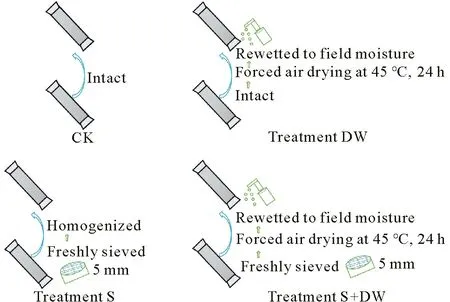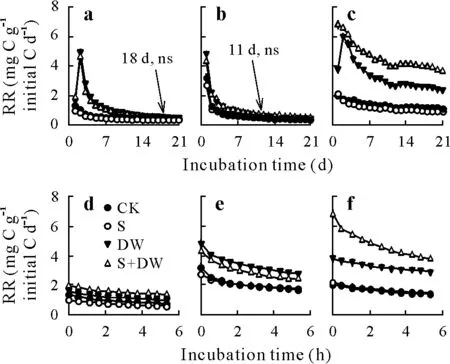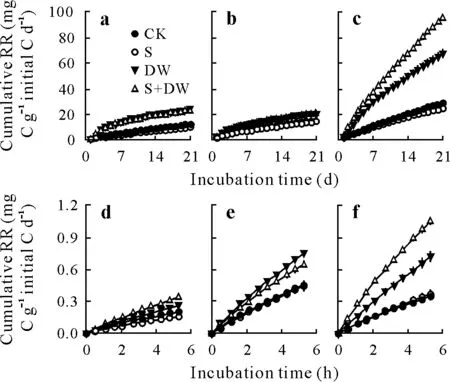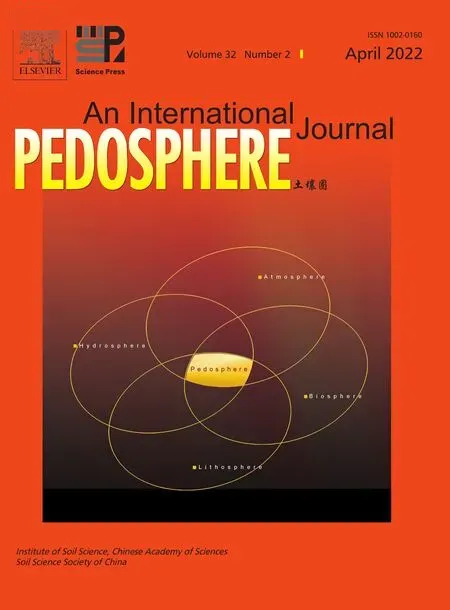Drying-rewetting rather than sieving stimulates soil respiration
2022-05-11JunjieLIN,WeixinCHENG,ShuaiZHANG等
Dear Editor,
Soils contain the largest carbon(C)pool in terrestrial ecosystems.Even a small change in soil C pool may significantly influence atmospheric carbon dioxide(CO2)concentration.Thus,it is critical to accurately assess the response of soil C pool to global change.Soil incubation is a frequently used method to assess soil C decomposition rate because it allows environmental variables to be under control(Ungeret al.,2010;Shi and Marschner,2014).However,pre-treatments during soil sampling and processing,such as sieving and drying-rewetting,inevitably bring physical disturbances which may affect soil respiration rate(Franzluebbers,1999;Thomsonet al.,2010;Curtinet al.,2014).
Physical disturbances associated with sieving fresh soils often destroy soil structure and disperse large aggregates into small aggregates or particles.Such disturbance may make physically protected soil organic matter(SOM)vulnerable to microbial degradation by increasing oxygen diffusion and substrate accessibility(Beareet al.,1994;Sixet al.,2002).Moreover,drying-rewetting may increase soil respiration through two main mechanisms(Schimel,2018;Zhanget al.,2020):i)exposing physically protected C to microbial metabolism by aggregate dispersion(Wu and Brookes,2005;Xianget al.,2008)(physical mechanism)and ii)increasing the supply of readily assimilable substrate to surviving microbial populations by utilizing microbial necromass and releasing intracellular solutes previously concentrated within microbial cells(physiological mechanism)(Van Gestelet al.,1992;Blazewiczet al.,2014).Thus,the disturbances associated with soil sampling and processing before measurement can potentially lead to overestimation of soil respiration.However,the effects of sieving and drying-rewetting on soil respiration rate have not been simultaneously compared and quantified.Therefore,we determined the dynamics of soil respiration using intact soil cores sampled from three ecosystems,forest,grassland,and cropland,in a 21-d laboratory incubation experiment under different soil disturbances with sieving and/or drying-rewetting.Our main objective was to compare the effects of sieving and drying-rewetting on soil respiration rate across three contrasting ecosystems.We hypothesized that:i)drying-rewetting would have a stronger and longer stimulation effect on soil respiration compared to sieving and ii)the effects of both types of disturbances on soil respiration would be stronger in cropland with relatively weaker soil aggregate stability compared to forest and grassland.
We collected soils from the top 25 cm of a forest,a grassland,and a cropland in the campus of the University of California,Santa Cruz in 2017.Soil properties are shown in Table I.At each ecosystem,four random locations were chosen,and each of them was considered as a field replicate.Four soil cores were collected at each location using preweighed copper tubes(5 cm inner diameter and 25 cm height)and then immediately brought to the laboratory.The 16 soil cores from each ecosystem were divided into four groups and separately subjected to four treatments(Fig.1):i)no-disturbance control(CK),ii)sieving through a 5-mm screen(S),iii)forced air drying at 45°C for 24 h and immediately rewetting to field moisture(DW),and iv)sieving through a 5-mm screen,forced air drying at 45°C for 24 h,and immediately rewetting to field moisture(S+DW).We measured soil respiration rate during 21-d incubation using the method described in Gershensonet al.(2009).The loss of soil moisture was less than 1%during the whole incubation.Soil subsamples,30 mg each,were analyzed for total C and N with an elemental analyzer(Elementar Vario EL,Germany),and subsamples 5 g each were measured for soil organic matter(SOM)by mass loss on ignition.

Fig.1 Diagram of soil physical disturbance treatments,no-disturbance control(CK),sieving(S),drying-rewetting(DW),and sieving plus dryingrewetting(S+DW),used in this study.
To evaluate the dynamic changes in soil respiration after rewetting,we conducted a meta-analysis including 244 observations of soil respiration rate after rewetting.We searched for relevant articles in Web of Science(until January 10,2020)using the search terms“dry wet”,“dry rewet”,“dry rewetting”,“drying rewetting”,“drought rewet”,“drought rewetting”,“rewet”,“rewetting”,“rewetted”,“carbon”,“organic matter”,“soil respiration”,“basal respiration”,“heterotrophic respiration”,and a combination of these terms.We also searched for articles that were cited in the articles we found.The articles found should meet the following criteria:i)experiments have a control with constant-moisture at the optimum moisture content(i.e.,the soil has the highest respiratory rate at this moisture content),ii)the soil moisture is maintained at the optimum after rewetting in the drying-rewetting treatment,iii)the soil of the control is not flooded(i.e.,soil moisture is lower than water-holding capacity and soil is in aerobic state),and iv)no external C source is added during soil incubation(i.e.,there is no priming effect).For studies with multiple drying-rewetting,we took the observations only after the first rewetting.Data from the figures were extracted using WebPlotDigitizer data extraction software(Burdaet al.,2017)to convert data points to numerical values.Following the above criteria,13 published articles were selected,including 244 quantitative measurements of the soil respiration rate(Beareet al.,2009;Butterlyet al.,2009;Muhret al.,2010;Thomsonet al.,2010;Liet al.,2011;Kaisermannet al.,2013;Meisneret al.,2015;Sunet al.,2015,2017;Sawadaet al.,2017;Shi and Marschner,2017;Yanget al.,2017;Naganoet al.,2019).All results were expressed on per unit of initial soil organic C(SOC)basis.Curve fitting was performed using SigmaPlot12.5(Systat Software,Inc.,USA)and statistical analysis was performed using IBM SPSS Statistics 20(IBM,Inc.,USA).Meta-analyses and the locally weighted polynomial regression(LOESS model)analysis were performed in R(version 3.5.1,R Development Core Team,2018)with the metafor and ggplot2 packages,respectively.
As expected,soil respiration rates in all three ecosystems initially declined sharply and then remained stable in the first 6 h and the following 21 d(Fig.2).Soil respiration rates in the treatments with drying-rewetting(DWand S+DW)were significantly higher than those without drying-rewetting(CK and S)in all three ecosystems.However,the response of soil respiration rate to drying-rewetting tended to disappear at approximately 18 d for the forest,11 d for the grassland,and more than 21 d for the cropland.In our meta-analysis,the average maintenance time of CO2pulse was 25 d(Fig.3).The decline of soil respiration rate over time can be explained by the depletion of available substrate and/or the decrease in microbial biomass(Fiereret al.,2003;Shi and Marschner,2017).Thus,the soil respiration rate may be overestimated when the pre-incubation period is not long enough to account for the initial disturbance effect of drying-rewetting treatment.

Fig.3 Effect size of soil respiration rate(RR)after rewetting in the three ecosystems of this study(forest,grassland,and cropland,n=20 for each ecosystem)and other ecosystems in the relevant articles(n=244)we searched in Web of Science.The effect size was calculated as the soil respiration in the sieving plus drying-rewetting treatment relative to the soil respiration in the sieving treatment(where soil moisture after sieving was always maintained at the optimum constant value).The line was obtained by best fit using a locally weighted polynomial regression(LOESS model).Grey area represents the 95%confidence interval of the line.Each symbol represents one observation.The effect size value>0 represents a positive effect,and the effect size value<0 indicates a negative effect.

TABLE I Soil properties measured after incubation

Fig.2 Instantaneous soil respiration rates(RR)during the 21-d incubation(a—c)and the first 6 h of incubation(d—f)in the three ecosystems studied,forest(a and d),grassland(b and e),and cropland(c and f),under various soil physical disturbance treatments,no-disturbance control(CK),sieving(S),drying-rewetting(DW),and sieving plus drying-rewetting(S+DW).Values are means with standard errors shown by the vertical bars(n=4).ns=no significant difference between CK and DW and between S and S+DW.
Contrary to our expectation,we did not find a significant response of instantaneous or cumulative soil respiration to only sieving in all three ecosystems(Figs.2,4,and 5).This indicated that the physical disturbance associated with sieving and handling did not significantly affect soil respiration.Other studies(Table II)also showed that soil respiration was not affected by the physical disturbance of fresh sieving through 5,4,or 2-mm mesh at field moisture.Notably,soil respiration increased after sieving when the large aggregates were broken into small aggregates<0.3 mm(Balesdentet al.,2000),which was because the physical disruption of aggregates can promote the exposure of SOM physically protected by aggregates to soil microorganisms and thus facilitate the decomposition of SOM(Denefet al.,2007;Curtinet al.,2014).Moreover,the shift in soil microbial community structure in the S treatment was not as large as that in the DWtreatment(Thomsonet al.,2010).In addition,the DWtreatment affected soil respiration in the forest and grassland,while the S+DW treatment was found to affect soil respiration in the cropland(Table III).Compared with the forest and grassland soils,the physical and physiological mechanisms may both occur in the cropland soil,providing more substrates for microbial respiration and thus causing longer duration of CO2pulse after rewetting(Steenwerthet al.,2005).Thus,physical disturbance by sieving alone had a minimal impact on soil respiration,but the impact would be significant when sieving was combined with dryingrewetting.
In summary,results from both the experiment and the meta-analysis clearly showed that soil respiration was mainly influenced by drying-rewetting rather than sieving under controlled laboratory conditions.The CO2pulse caused by initial disturbance would be avoided if pre-incubation was prolonged to 18 d or more for forest and grassland soils.The cropland soil was more vulnerable to the combination of sieving and drying-rewetting than the forest and grassland soils,likely due to differences in disturbance history.Taken together,these results may facilitate better design and interpretation of laboratory incubation experiments for quantifying SOMdecomposition.

Fig.4 Changes in cumulative soil respiration rate(RR)during the 21-d incubation(a—c)and the first 6 h of incubation(d—f)in the three ecosystems studied,forest(a and d),grassland(b and e),and cropland(c and f),under various soil physical disturbance treatments,no-disturbance control(CK),sieving(S),drying-rewetting(DW),and sieving plus drying-rewetting(S+DW).Values are means with standard errors shown by the vertical bars(n=4).

Fig.5 Total cumulative soil respiration rates(RR)over the 21-d incubation(a)and the first 6 h of incubation(b)in the three ecosystems studied,forest,grassland,and cropland,under various soil physical disturbance treatments,no-disturbance control(CK),sieving(S),drying-rewetting(DW),and sieving plus drying-rewetting(S+DW).Values are means with standard errors shown by the vertical bars(n=4).Bars with different letters denote significant differences at P<0.05 within an ecosystem.
ACKNOWLEDGEMENTS
This work was supported by the National Natural Science Foundation of China(Nos.31770529,31971528,and 31988102),the Program of Chongqing Science and Technology Commission,China(No.cstc2020jcyj-msxmX0095),and the Science and Technology Research Program of Chongqing Municipal Education Commission,China(Nos.KJZD-K202001203 and KJZD-K202003501).We thank all the scientists whose data and work were included in the meta-analysis.

TABLE II Summary of similar studies on the effects of physical disturbances,sieving(S),dry-wetting(DW),wetting(W),and drying(D),on soil respiration rate we searched in Web of Science

TABLE III Two-way analysis of variance(ANOVA)on cumulative soil respiration rate under various soil physical disturbance treatments,sieving(S),dryingrewetting(DW),and sieving plus drying-rewetting(S+DW),during the 21-d incubation
杂志排行
Pedosphere的其它文章
- Ultraviolet B radiation-mediated stress ethylene emission from rice plants is regulated by 1-aminocyclopropane-1-carboxylate deaminase-producing bacteria
- Methanotrophy-driven accumulation of organic carbon in four paddy soils of Bangladesh
- Complementary effect of zoo compost with mineral nitrogen fertilisation increases wheat yield and nutrition in a low-nutrient soil
- Comparison of potential potassium leaching associated with organic and inorganic potassium sources in different arable soils in China
- A conceptual framework and an empirical test of complementarity and facilitation with respect to phosphorous uptake by plant species mixtures
- Evaluation of immobilizing agents as soil quality conditioners in addition to their metal(loid)immobilizing effect
